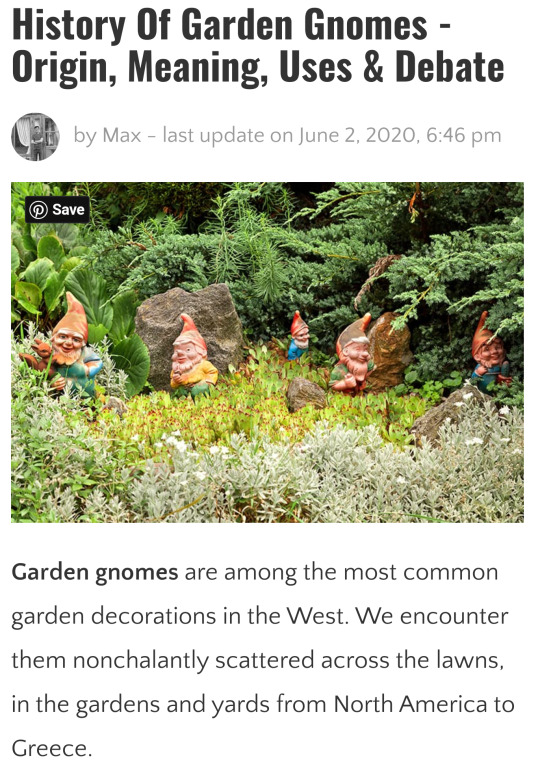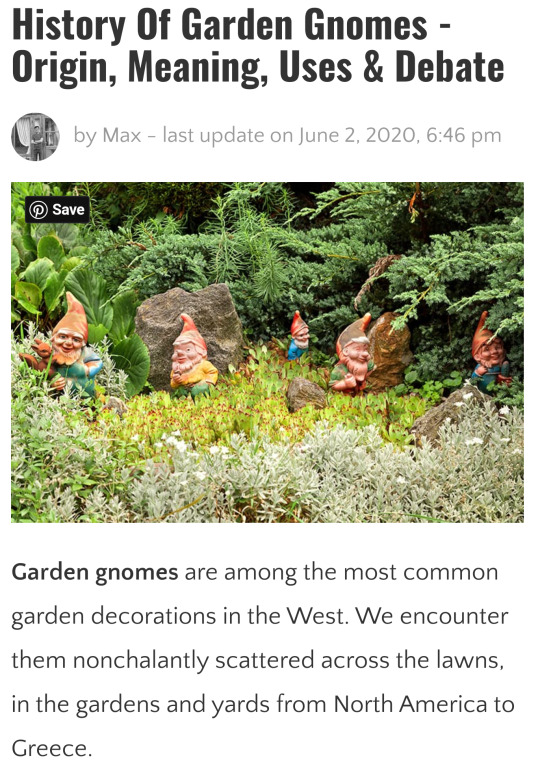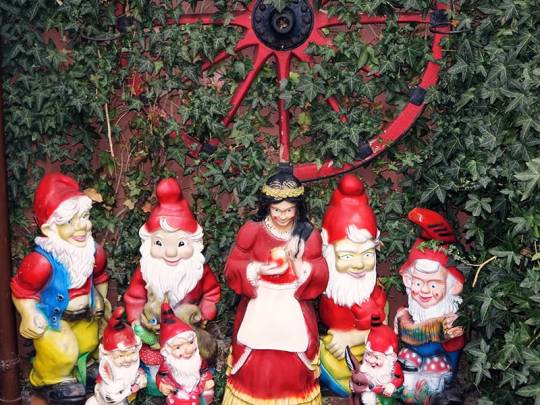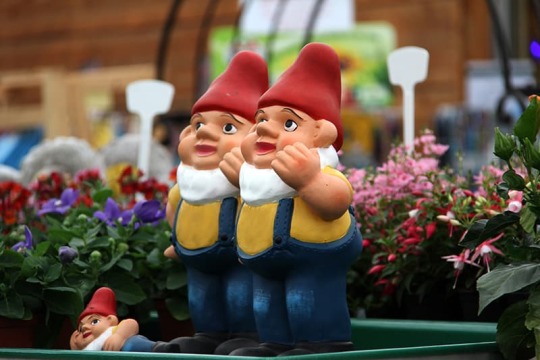#MaxGnomes
Text
History of Garden Gnomes Thoughts
So a few days ago I posted this article by Max! It is pretty lovely but I do have some responses to it since it has made me think pretty hard about a few things in it!

Max did an epic job writing this and doing some serious Gnome research! I will say though that I am not sure why he put them in the West... they are all over literally everywhere! if you keep your eyes peeled you will find them all the time!

I do not like that he says they are just male... that is totally not the case! Female gnomes may be uncommon but they are gnomes! GNOMES DON’T HAVE TO BE MALE!
Gnomes still are good luck charms! Most just got associated to Garden magic instead, not only that Leprechauns exist too and the luck became more their vibe than gnomes but gnomes are definitely lucky little creatures!
Garden Gnomes Meaning
During this section I learned what etymology is, the study of a word’s origin and its changed meaning over time.
Paracelsus gets more explained later but he is used here without explanation as an explanation which bothered me. For reader clarity Paracelsus is a Swiss physician, alchemist, and philosopher. He actually has a lot more importance than they gave him since he is basically the person who made up gnomes! I will post his more in depth crazy article later!
Basically though they believe the word Gnome came out of the Greek language either ‘genomos’ or ‘gnosis’ meaning earth dweller and knowledge. I think personally that a combo of the two is most likely because Gnomes live forever in the Earth really so they are very very knowledgeable about Earthly things.
Petite Gnome In Ancient Rome
The first thing about this section that got to me was the picture... why have a picture without a gnome in it to show that gnomes were in Ancient Rome!
But to be fair I couldn’t find a good picture for it either.... I did find a cool one from Turkey that will be shown off later!
I wish we could see one though and some of the god statues that paved the way for gnome statues! not to mention naughty gnomes since the most common God Priapus had a permanent erection!
Early Modern Period-From Gobbi to Lampy

So now after all that we finally get to find out who Paracelsus is and why he is relevant! So during the Renaissance Era the gnome statues had a spiritual connection as well! Paracelsus is who said they have magical powers (which they do!!!) So he said they were one of the four elementals or nature spirits that were invisible to humans but belonged to the Earth. Gnomes in particular would come out at night to help the plants grow!
They also had another name during the time period of ‘Grotesques’ which at that time was pleonastical because it was very obvious they were not very good looking at time. They were made a ugly petite hunchbacks. Then painted bright colors and called Gobbi which is Italian for hunchback.
Not gong to lie to you all Gobbi sounds a lot like Gabby and I do have the worst posture so this felt like cruel fate!! But will say totally fits and makes a lot of sense to me why I love them soooooo much!
If I was from that time period I would have had the wealthiest family for the amount of gnomes I have!
The popularity of gnomes grew due to all of the folklore and stories with them in it! Epp which makes gnome what they are today!
The First Garden Gnome
The iconic red hat gnome came form a sculptor named Phillip Griebel from Germany!! I love love love that his name is Griebel because it is real close to me true name Gabrielle! I just feel like it was meant to be! I was always supposed to be with the gnomes! Can you believe all these years later his factory still is there and producing gnomes?!
So a while later Sir Charles Isham showed up and brought Griebel’s gnomes over to England! He was believed to start the tradition of Garden Gnomes in the United Kingdom! Gnomes became nicknamed Lampy because Lamport Hall is what made them famous! There is another article of this coming later ;) One still exists and is being preserved at the family residence!
So fun fact one of my sorority sisters is an Isham! She also saved and preserved some of my gnomes from frat boys so I think it was another meant to be moment! Isham helps ‘Gobbi’ Griebel!
The 20th Century- Intermittent Rise And Fall Of Gnome
So I totally get the less money less gnomes thing but I never remotely thought about how gnomes would be impacted by war so that was an eye opening moment.
Snow White and the 7 Dwarfs restoring the glory of the garden gnome got to me... awww no way that happened!!! DRAWFS ARE NOT GNOMES! GNOMES ARE NOT DRAWFS! but I kept reading trying to see Max’s logic.... BECAUSE THEY LOOK SIMILAR!? WHAT!?!?!? Oh I can not get on board with the logic here! I think that many other things helped them out way more but hey not my article!
But seriously why that picture? It is not very snow white... guess it is somewhat gnomie...
I personally am so glad gnomes went to mass production or I would not be able to have a lot! I know that the quality is different but I do not think it is lesser and having gnomes of all sorts is so much more of a blessing than before!! Not less artistic either it is just a different artistic expression! The fall from being only for the wealthy is the best thing that could have ever happened to gnomes!
The Traveling Gnome Prank
Since this happens to me a lot I have a bit of bad vibes! I need to find these pictures of the Antarctica gnome travels that started it all!
Garden Gnome Liberation Front deserves there own posts for sure and will get it but i have a serious love hate with them.... but gnomes do deserve travel freedom! I will say I need more of the epic pictures of gnomes with landmarks!
I have never got one of gnomes back with a travel diary but they really should be! It would make their absence bearable for me!
Amelie is a great movie with one of the cutest gnomes I have ever seen but I will say I hate that it encourages people to take my gnomes on adventures without me!
Gnomes' Red Cap
The Phrygain Cap is the most known thing about a Garden Gnome! I did not know that a gnomes hat had a specific name before this article so I thought it was an awesome fun fact! Really the hat had a whole different vibe before the gnome got to it! But it does make the liberation of garden gnomes and giving them freedom make a lot more sense because those hats used to be the symbolization of freedom and is still worn by nation symbols of France today!
Making of Garden Gnomes
Once again why pick a picture without a gnome in it? I’m sure there are a few of someone out there sculpting a gnome....
Also terracotta clay gnomes are the cutest but also the worst because they break sooooo easily!!! I actually have one I have to fix :(
I need to find all these tutorials and try them honestly!
Types of Garden Gnomes
I am so so glad he amends the male part of garden gnome here and includes females and the babies! Gnome families are real!
Can we just say gnomes are branching out into doing more things of modern culture like playing with a cell phone or being a scientist!
Uses of Gnomes In The Garden
Now the box he puts gnomes in here is not ok to me... they can go literally anywhere and everywhere! Plus they come in so many different forms! Like necklaces, shirts, sheets, the kitchen!!! ANYWHERE! There is a gnome for that I swear!
Gnomes, from Gardening to Popular Culture
So now he kind of shares some gnomes that are not meant to be lawn care takers... once again GNOMES ARE NOT DRAWFS!
I have to admit I am glad the operating system is called GNOME but I hate when I search gnome and only that jazz pops up!
Social Deomcratic Party of Austria used gnomes for marketing and a post of this will come later because I didn’t even know that existed until this article!
A post of gnomes in the mentioned novels will come too because I need to see the reference of these in some of them... I have no idea where the gnomes are!
Travelocity thank you for using a gnome and its cool pictures but it encourages people to take mine toooo much! Plus my Travelocity gnome named Gnomad has never been returned! A post of their twitter is needed though!
I need to check out the George Harrison album with gnomes... another post that will appear!
Gnomeo and Juliet and Sherlock Gnomes are so amazing I hope they make a thrid! Please Elton John Please!
A post on all the festivals around the world that have gnomes will have to come! I need to know where all of these are!!!!
Truly this portion of the article has made it so I have to go down the well and learn more about these gnome appearances!
Garden Gnome Aesthetical Debate
Why is there a picture without gnomes in it?!?! Seriously they were jsut let in so they better be int he picture!!!
2013!!!! 2013!!! The gnomes were just accepted in 2013.... that is crazy to me! I am so glad they are allowed now! Next is to get rid of the gnomophobes and garden snobs!!!
Conclusion
Garden Gnomes are just a big part of life and if you say otherwise you aren’t using your eyes! I don’t think they are a stereotype either!!! or a sweet cliche!!
Yes I do have garden gnomes in the garden but I don’t really have a garden...
Gnomes are Beautiful artistry and the best creatures on the planet really! If you think they are expressions of bad taste we can’t be friends!!
YESSSSSSS GNOMES ARE JUST SOOOOOO CUTE!
I just did a whole response to your article so I will skip writing in the comments :P

Welp that concludes my thought on this article and it taught me a lot and gave me a lot of other gnomes to look into! I hope you feel the need to check some of these gnomes out as well!
https://www.greenandvibrant.com/history-of-garden-gnomes
#GnomeResponse#GnomePun#gardengnomes#gnomes#gnomelove#gnomegirlgabby#GnomeWant#NeededGnomes#GnomeArticle#GreenAndVibrantGnomes#MaxGnomes#GnomeFacts#GnomeHistory#GnomeThoughts#GobbiGnomes#RedHatGnomes#TravelocityGnomes#gnomeo and juliet#SherlockGnomes#gnome chompski
0 notes
Text
So there is this cool gnome article! Thanks for writing this Max!


Garden Gnomes Meaning
The etymology of the word "gnome" is not completely clear. Paracelsus, named elemental earth beings pigmaei or gnomi to, possibly from the Greek word "genomos" meaning "earth-dweller."
It is less likely that "gnomus" was derived from the similar-sounding Greek word gnosis, meaning "knowledge."
Petite Gnome In Ancient Rome
The earliest appearance of garden gnome-like statues was in ancient Rome. Their garden forerunners were statues that represented the Roman gods.
The most common among them was the god Priapus, a minor fertility deity who originally came from Greek mythology. He was a protector of livestock, planting, and gardening, which was symbolized by the depiction of his… Well, permanent erection.
The primary function of these statues was to protect the gardens from evil spirits, as well as to ensure a successful harvest.
Early Modern Period-From Gobbi to Lampy

Swiss Alchemist Paracelsus Was The First One To Described Gnomes As Creatures With Magical Powers
In the Renaissance era, the grotesque potential of those statues was expanded following the general spirit of the age.
Swiss alchemist Paracelsus was the first one who described them as creatures with magical power. According to him, gnomes were one of the four elementals or nature spirits (invisible beings that existed among humans), belonging to the earth. They would come out at night to help plants grow. During this period, gnomes were pleonastically called "Grotesques" and thus were made to be ugly petite hunchbacks, painted in bright colors and usually named by the Italian word "Gobbi."
Garden gnomes became widely popular as home ornaments by the beginning of the 18th century, but mostly for wealthy families only.
The popularity of gnomes persisted thanks to the folklore, myths, and stories from around the world, such as German fairy tales, where gnomes and dwarfs were present largely as little creatures with mythical power helping humans in farming. They were a good example of how folklore and mythology influenced the history of everyday life.
The First Garden Gnome
It is believed that the very first contemporary-looking garden gnome (with the iconic red hat), was made in Germany by sculptor Phillip Griebel. Soon, the fashion had spread across Europe, from England to Poland, and Griebel concentrated his entire manufacturing around producing garden gnomes.
Consequently, the manufacture of gnomes became very common in Germany, with different businesses emerging across the country, although Griebel remained famous among them, and still exists as a family business in Germany.
In the 19th century, Sir Charles Isham brought several of Griebel’s gnomes to England, introducing them to the new market. He is credited with beginning the tradition of garden gnomes in the United Kingdom, where they were nicknamed "Lampy." One replica is still preserved and displayed in Lamport Hall, the Isham family residence in Northamptonshire.
The 20th Century- Intermittent Rise And Fall Of Gnome
The beginning of the modern era in Europe brought troubling and uncertain times, which culminated with World War I and World War II. Their consequences changed the course of modern history, as well as leisure time habits. Unsurprisingly, the popularity of garden gnomes was in decline during this period.

The Snow White And Seven Dwarfs Movie lay in restoring the glory of Garden Gnomes in the 21st Century
However, thanks to popular culture, garden gnomes have returned to homes and gardens in Europe once again. In 1937, Walt Disney Productions released "Snow White and the Seven Dwarfs," as an animated musical fantasy movie. Decades later, in 1989, the movie was recognized for its cultural and historical significance, thus being preserved in the National Film Registry. Part of its cultural influence lay in restoring the glory of garden gnomes, whose physical similarity with dwarves was more than obvious.
Since the 1970s, the mass-production of garden gnomes has replaced handicrafts. The variety of materials was greater than before, and many gnomes were now made of plastic. This type of production led to lower quality compared to the handmade gnomes.
However, such manufacture made garden gnomes more affordable and thus available to a wider market. However, they have lost the artistic value they once had. They traveled a long road from exclusive decoration for the wealthy and powerful, to the ornament frequently displayed in middle and working-class gardens.
The Traveling Gnome Prank
The "Traveling gnome" is a game that dates back to the 1970s. It started when one traveler photographed two of his gnomes during his travel around Antarctica.
It became widely popular during the 1990s, when a community in France named the Garden Gnome Liberation Front made a prank out of it, stealing gnomes and taking them traveling.
The concept was to give the gnomes freedom they were believed to want.
Thieves usually sent photographs of the gnomes to the owners, showing them that their minions were safe and sound, in their newly gained freedom and independence. This community dedicated itself to the purpose of "freeing garden gnomes."
Over time, the prank became popular on a global scale, with many cases of stolen traveling garden gnomes and their photographs in front of famous landmarks worldwide. Instead of some random backyard somewhere in the UK or Germany, the "traveling gnomes" could be seen in front of London’s Big Ben and Paris’ Eiffel Tower. Such cases often took part in news, both in North America and Europe.
One of the latest was telling a story of a Canadian lady, whose garden gnome was missing for eight months. Finally, the gnome was returned to her, along with his travel diary. This book, containing stories and pictures of his travels all the way from his Canadian home in Vancouver Island to the Baja Peninsula in Mexico.
Such hard work proved the commitment of pranksters and the practitioners of the Traveling Gnome game around the world.
In 2001, the traveling garden gnome theme became the basis of the famous French movie "Amélie."
Gnomes' Red Cap

The Garden Gnome trademark has always been the so-called Phrygain Cap
The garden gnome trademark has always been the so-called Phrygian cap. It’s a soft, conical hat, usually painted bright red. It originates from the Hellenistic period, as it is preserved in depictions in Greek vase-painting and sculpture.
Nowadays, the hat is known as a Gnome and has got a brand new meaning. In revolutionary France, the Phrygian-style cap became a symbol of revolt against the establishment, called "Bonnet rouge." It was first documented in 1870.
This is why the national symbol of France, Marianne, is always depicted wearing a red Phrygian cap. Since Marianne is a personification of liberty and equality, it is easy to bring together such tradition with the aforementioned Traveling Gnome prank, whose aim was to free gnomes from their garden prisons. No wonder this joke has bloomed in France, the very cradle of the modern concept of liberty.
Making of Garden Gnomes
Garden gnomes are typically shaped in the human form as small statues. Through centuries, they have been traditionally handmade from terracotta clay, using a mold. Once its shape got firm, the gnome could be removed from the mold.
The next step was drying and heating in a kiln, a special type of oven used for firing pottery until it got hard. The final step included painting and brushing the gnome in bright colors.
With the development of technology, the manufacturers started to use some other materials, such as resins and, more lately plastic.
Today, there are many tutorials on how to make a garden gnome at home available online.
Types of Garden Gnomes

The details of the appearance of garden gnomes have gone through many changes over the centuries.
The majority of them are shaped as males with long, white beards and pipes. Female gnomes were rather rare and usually without the beard, but having a simple dress, and the same pointed hat as the male ones. It is why they can look somewhat like witches. They can also be displayed as a gnome family, consisted of a mother, father, and children.
Since they were supposed to help with sweeping and planting, according to the legend, traditional garden gnomes were usually depicted holding garden tools such as shovels or wheelbarrows. More modern gnomes are rather represented during their spare time – reading, fishing or napping.
Uses of Gnomes In The Garden

There are various uses of gnomes in gardening. They can be put on different places around the garden or around the house: hidden in your backyard, in the flower beds or bushes.
Gnomes will also do well as decoration near a water feature - a pond or a fountain; they can reflect in the water. They can also be incorporated in solar lighting installations.
Also, a garden gnome can be placed somewhere around the front yard, for example at the front steps, where he can serve as a centerpiece. In the context of front yards, gnomes can make dull lawn patches more fun and interesting.
Gnomes, from Gardening to Popular Culture
As I mentioned before, garden gnomes became a significant part of popular culture nowadays, having appeared in many movies, commercials, and video games. After gaining popularity in Disney’s "Snow White and Seven Dwarfs," gnomes played roles in several more movies and books.
From a popular open-source desktop environment for Unix-like operating systems named GNOME to the marketing use of gnomes by the Social Democratic Party of Austria, gnome-like creatures remained the popular determinant of western culture. Not to mention famous novels written by J.R.R. Tolkien, C.S. Lewis, J.K. Rowling, and Terry Pratchett.
Travelocity, an American online travel agency launched a series of viral marketing advertisements called "Where is my Gnome?" Its mascot, a very well-known garden gnome with black boots and red hat, became known as "the Roaming Gnome." Travelocity also created an official profile for the Roaming Gnome on Instagram and Twitter. Fans can follow his international escapades regularly, watching photographs of a cute gnome eating pizza in Italy, traveling on a plane or striking a pose in front of the Golden Gate Bridge in San Francisco.
The cover of the famous George Harrison’s solo album "All Things Must Pass" contains gnomes that belonged to Sir Frank Crisp at Friar Park in Oxfordshire, another British gnome collector from the late 19th century.
Onto the big screen, "Gnomeo and Juliet" and its sequel "Sherlock Gnomes," are British-American production animated movies. The original was inspired by Shakespeare’s tragedy "Romeo and Juliet," using its plot to tell a story in which gnomes are the main characters, reuniting two families, that used to be enemies. Art can use different traditions very well, and this movie is a good case in point.
One of the contemporary marks of garden gnomes is the process of their personification. Sometimes, they are given a specific voice and personality, to serve some artistic or comical purpose. One of the more famous examples is the Gnome Chomsky, made after Noam Chomsky, an American philosopher, linguist, and political activist, and he could be ordered online in several sizes.
There are also several gnome festivals around the world, conducted in many countries from the United States to Australia, celebrating those mythical creatures.
Garden Gnome Aesthetical Debate

The garden gnomes we banned in the Chelsea Flower show until 2013
The fame always comes with a flipside. It is certain that garden gnomes have a love-hate relationship with the public. A notorious example of that is the Chelsea Flower Show.
After years of appeals and protests, in 2013 the Royal Horticultural Society of Britain lifted a ban on using garden gnomes at the Chelsea Flower Show, to the joy of gnome lovers and to the horror of those who see the garden gnomes as the ultimate kitsch. The latter group has often been labeled "garden snobs" and "gnomophobes."
Since the Chelsea Flower Show is the most influential garden-related event in a country with a long gardening tradition, such a debate was expected.
Conclusion
From the very beginning of Western civilization, gardening was an important element of everyday life and relaxation. Garden gnomes have been given a big role in it. Related specifically to the gardening tradition, they remained the most common stereotype of home gardens across the world. Garden gnomes are a sweet cliché.
On the other hand, seen as kindred spirits and human little helpers, deeply rooted in our tradition and mythology, they became an inevitable part of every childhood. The stories they portray maintain the continuity of the culture, even beyond gardening.
Do you have garden gnomes in your garden? Do you think they are beautiful artistry or the expression of bad taste? And lastly - aren’t gnomes just cute? What do you think? Let us know in the comments.

Thank you for your article! It was much appreciated my thoughts on it are coming! Some of these things really made me think 😳
https://www.greenandvibrant.com/history-of-garden-gnomes
#gnomelove#gnomegirlgabby#gnomes#gardengnomes#gnomesgnomesgnomes#gnomewant#neededgnomes#GnomeArticle#GreenAndVibrantGnomes#MaxGnomes#GnomeFacts
0 notes